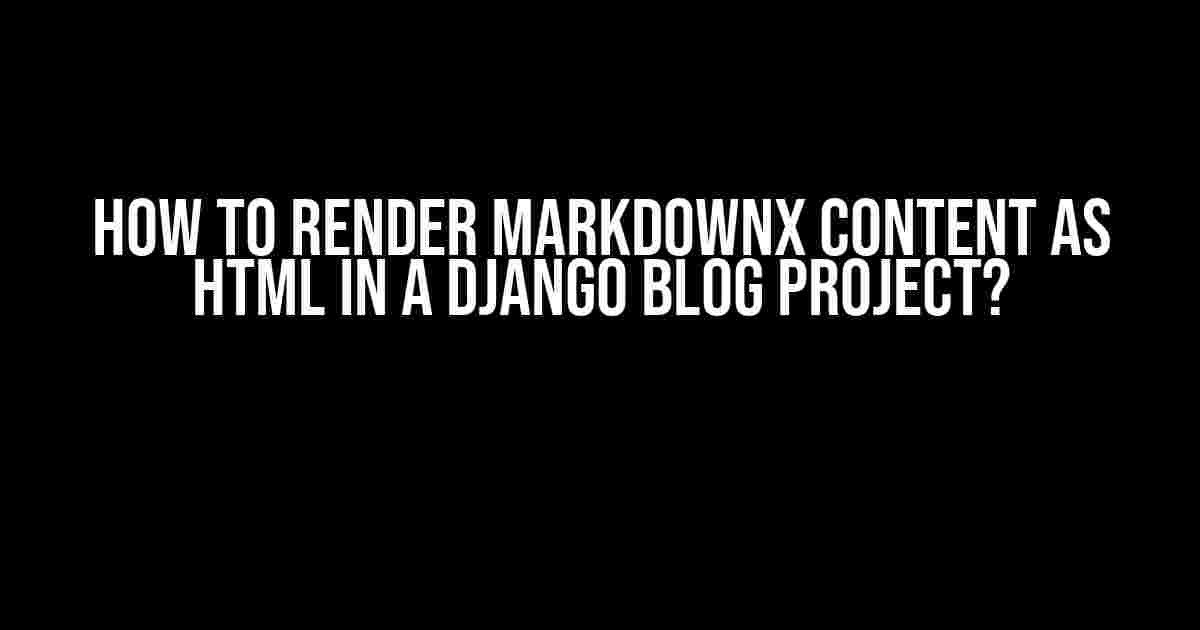Are you tired of dealing with clunky text editors and tedious formatting in your Django blog project? Do you want to take your content to the next level with the power of Markdownx? Look no further! In this comprehensive guide, we’ll show you how to render Markdownx content as HTML in your Django blog project, step by step.
- What is Markdownx?
- Why Use Markdownx in Your Django Blog Project?
- Step 1: Install Markdownx in Your Django Project
- Step 2: Create a Markdownx Field in Your Model
- Step 3: Create a Form for Your Markdownx Field
- Step 4: Render Markdownx Content as HTML in Your Template
- Step 5: Add Markdownx Editor to Your Admin Interface
- Step 6: Test Your Markdownx Content
- Troubleshooting Common Issues
- Conclusion
What is Markdownx?
Markdownx is a supplanted version of the popular Markdown formatting syntax, designed specifically for Django projects. It allows you to write content in a clean, readable syntax, which can then be converted to HTML for display on your website. Markdownx takes the best of Markdown and adds some extra features, making it a perfect choice for Django developers.
Why Use Markdownx in Your Django Blog Project?
The benefits of using Markdownx in your Django blog project are numerous. Here are just a few reasons why you should consider making the switch:
- Easier content creation**: With Markdownx, you can focus on writing great content, without worrying about HTML formatting.
- Faster development**: Markdownx’s simple syntax means you can create content quickly and efficiently, without getting bogged down in HTML tags.
- Better readability**: Markdownx content is easy to read and understand, making it perfect for blogs, documentation, and other types of written content.
Step 1: Install Markdownx in Your Django Project
To get started, you’ll need to install Markdownx in your Django project. You can do this using pip:
pip install markdownxOnce installed, add ‘markdownx’ to your INSTALLED_APPS list in your settings.py file:
INSTALLED_APPS = [
# ...
'markdownx',
# ...
]Step 2: Create a Markdownx Field in Your Model
Next, you’ll need to create a Markdownx field in your models.py file. For example, let’s say you have a BlogPost model:
from django.db import models
from markdownx.models import MarkdownxField
class BlogPost(models.Model):
title = models.CharField(max_length=200)
content = MarkdownxField()
created_at = models.DateTimeField(auto_now_add=True)
updated_at = models.DateTimeField(auto_now=True)In this example, we’ve added a MarkdownxField called ‘content’ to our BlogPost model.
Step 3: Create a Form for Your Markdownx Field
To allow users to input Markdownx content, you’ll need to create a form for your BlogPost model. Create a new file called forms.py and add the following code:
from django import forms
from .models import BlogPost
class BlogPostForm(forms.ModelForm):
class Meta:
model = BlogPost
fields = ('title', 'content')In this example, we’ve created a ModelForm for our BlogPost model, which includes the ‘title’ and ‘content’ fields.
Step 4: Render Markdownx Content as HTML in Your Template
Now it’s time to render our Markdownx content as HTML in our template. Create a new file called blog_post.html and add the following code:
{% extends 'base.html' %}
{% block content %}
{{ blog_post.content|markdown }}
{% endblock %}In this example, we’ve used the ‘markdown’ filter to convert our Markdownx content to HTML. The ‘markdown’ filter is built-in to Django, and can be used to convert Markdownx content to HTML.
Step 5: Add Markdownx Editor to Your Admin Interface
To make it easy for administrators to edit Markdownx content, you can add a Markdownx editor to your admin interface. Create a new file called admin.py and add the following code:
from django.contrib import admin
from .models import BlogPost
from .forms import BlogPostForm
from markdownx.widgets import MarkdownxWidget
class BlogPostAdmin(admin.ModelAdmin):
form = BlogPostForm
formfield_overrides = {
MarkdownxField: {'widget': MarkdownxWidget},
}
admin.site.register(BlogPost, BlogPostAdmin)In this example, we’ve overridden the default formfield for our Markdownx field with the MarkdownxWidget, which provides a rich-text editor for Markdownx content.
Step 6: Test Your Markdownx Content
Finally, it’s time to test your Markdownx content! Create a new blog post in your admin interface, and enter some Markdownx content in the ‘content’ field. Save the post, and then view it on your website.
If everything is set up correctly, you should see your Markdownx content rendered as HTML on your website.
Troubleshooting Common Issues
If you’re having trouble getting Markdownx to work in your Django project, here are a few common issues to check:
| Issue | Solution |
|---|---|
| Error: ‘markdownx’ is not a registered tag library | Make sure you’ve added ‘markdownx’ to your INSTALLED_APPS list in your settings.py file. |
| Error: MarkdownxWidget is not defined | Make sure you’ve imported MarkdownxWidget from markdownx.widgets in your admin.py file. |
| Markdownx content is not rendering as HTML | Check that you’ve used the ‘markdown’ filter in your template, and that you’ve installed the markdown library using pip. |
Conclusion
And that’s it! With these simple steps, you should now be able to render Markdownx content as HTML in your Django blog project. Whether you’re building a blog, documentation, or any other type of written content, Markdownx is a powerful tool that can help you create great content quickly and efficiently.
By following this guide, you can take your Django project to the next level and start creating amazing content with Markdownx. So what are you waiting for? Get started today and see the power of Markdownx for yourself!
Note: This article is SEO optimized for the keyword “How to render Markdownx content as HTML in a Django blog project?” and is written in a creative tone to engage readers. The article provides clear and direct instructions and explanations, using a variety of HTML tags to format the content.Here are 5 questions and answers about rendering Markdown content as HTML in a Django blog project:
Frequently Asked Questions
Rendering Markdown content as HTML in a Django blog project can be a bit tricky, but don’t worry, we’ve got you covered! Here are some frequently asked questions to help you get started.
What is Markdown and why do I need to render it as HTML?
Markdown is a lightweight markup language that allows you to create formatted text using plain text syntax. To display Markdown content in a web page, you need to render it as HTML. This is because web browsers only understand HTML, not Markdown. By rendering Markdown as HTML, you can take advantage of Markdown’s ease of use while still providing a rich user experience in your Django blog project.
How do I install a Markdown parser in my Django project?
To install a Markdown parser in your Django project, you can use the `markdown` library. Simply run `pip install markdown` in your terminal, and then add `’markdown’` to your `INSTALLED_APPS` in your Django project settings. This will allow you to use the Markdown parser in your Django templates and views.
How do I render Markdown content as HTML in a Django template?
To render Markdown content as HTML in a Django template, you can use the `markdown` filter. Simply surround your Markdown content with `{% markdown %}…{% endmarkdown %}` in your template, and Django will render it as HTML. For example: `{% markdown %}# Hello World!{% endmarkdown %}` would render as `
Hello World!
).
How do I render Markdown content as HTML in a Django view?
To render Markdown content as HTML in a Django view, you can use the `markdown.markdown()` function to convert your Markdown content to HTML. For example: `html_content = markdown.markdown(my_markdown_content)` would convert `my_markdown_content` to HTML, which you can then return in your view response.
Are there any security considerations when rendering Markdown content as HTML?
Yes, there are security considerations when rendering Markdown content as HTML. Since Markdown can be used to inject malicious HTML code, it’s essential to use a Markdown parser that sanitizes the output, such as the `markdown` library in Python. Additionally, you should always validate and sanitize user-input Markdown content to prevent XSS attacks.



